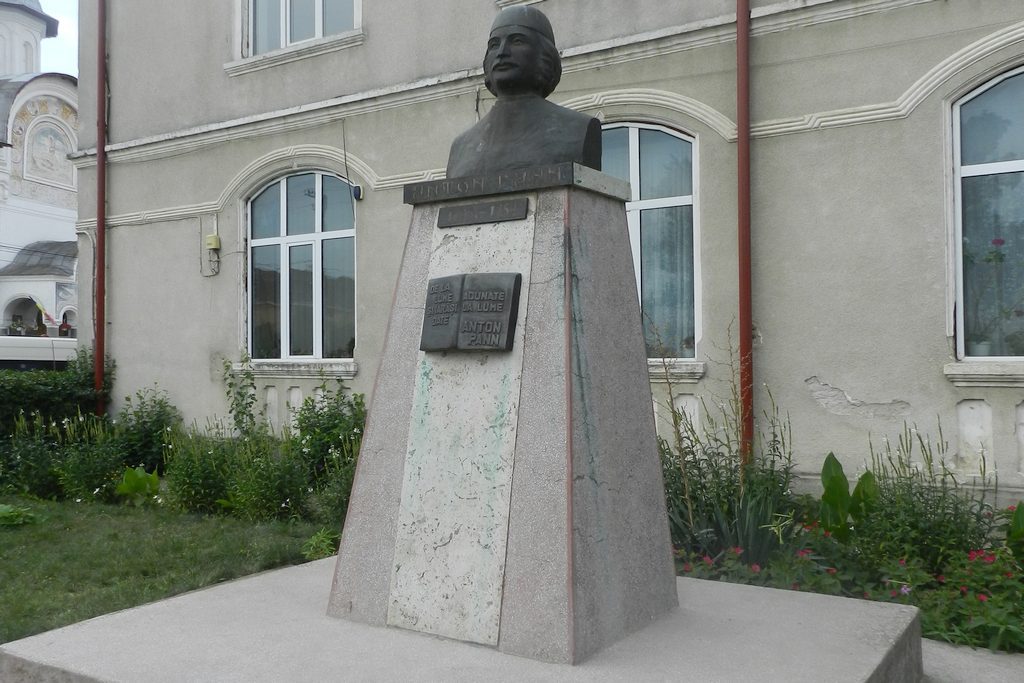

The bust was built up in the memory of Anton Pann, born around the years 1796 – 1798 in the locality Sliven from Bulgaria.
In the winter of 1812, he arrives, together with his mother, at Bucharest. Poor and without acquaintances among the inhabitants, because of his angel voices, he is firstly a sexton at the church Olari and singer II (deft) at the church “With Saints” from Calea Moșilor. Also in this moment he becomes an apprentice of the Greek teacher Dionisie Fotino. Therefore, willing to enrich his knowledge, he registers “as auditor” at the “school of music” opened by Fotino, “lettered writer and music composer”, perfect knower of the oriental music (1769 – 1821).
He also learns the craft of printing, in the typography of the same Petru Efesiul, and in 1819 he becomes “director” of the typography and prints for the first tine an Axion in Romania.
In 1820, Anton Pann gets married with a poor girl, with the name of Zamfira Agurezan. From this marriage he will have a son, Lazăr, who became quite late a priest.
During his stay at Râmnicu Vâlcea, Anton Pann lived in the immobile from the street Știrbei Vodă (today being the Memorial museum “Anton Pann”). In his activity from the Episcopacy, Anton Pann had as principal objective the Romanization and the modernization of the church music, the proof being the drafted manuscripts, consisting of sings specific to the Orthodox cult: polieleu, axion, and doxology. At the same time, he taught music lessons to the nuns from the monasteries “Dintr-un lemn” and “Surupatele”.
In the year 1830 he opens the series of his tipping with religious and laic content.
In the year 1838, his mother, Tomaida, dies. Remaining alone in the world, he decides to get marries again, with a young girl of 18 years of age, on the name of Ecaterina, daughter of Anița of Asanache, former prince wine month. Despite the opposition of their parents, who saw the big age difference between the two (26 years), the marriage took place on the 10th of February 1840, godfather being the bread-maker Tudorache Sfetescu. After twenty years of waiting he manages to type the New Doxastar, tome 1.
In the summer of the year 1844 we find him at the monastery Tismana, as guest of the archimandrite priest Spiridon, to whom he dedicates, in manuscript, the service of the Assumption of Mary. In the year 1846, he will print: Popular poems, Star songs, the IIIrd edition, Irmologhiu – Catavasier, the Epitaph and the Heruvian – Annalist. All these, were written with Cyrillic alphabet, in Romanian language, on ordinary paper and from Holland, with the behooved price difference.
In the year 1848, the year of the revolution from Islaz, his editorial – typographic activity is much reduced, managing to give light to only four books, of which two are laic, one with religious character, Star song, the IVth edition and the Wake. In parallel with the didactic work, he will develop the one of singer at the Church Kretzulescu, where he managed to form a quire of young people, paid each with 20 RON per month.
His didactic activity stopped in the period 1848 – 1849, his seminary being closed and opened later on, in the year 1851.
He dies on the date of the 2nd of November 1854, at the return from a journey through Oltenia, from where he contracted a powerful illness (virulent tifus). He is buried at the Saint Stelian Church (Lucaci) from Bucharest, near his home.
